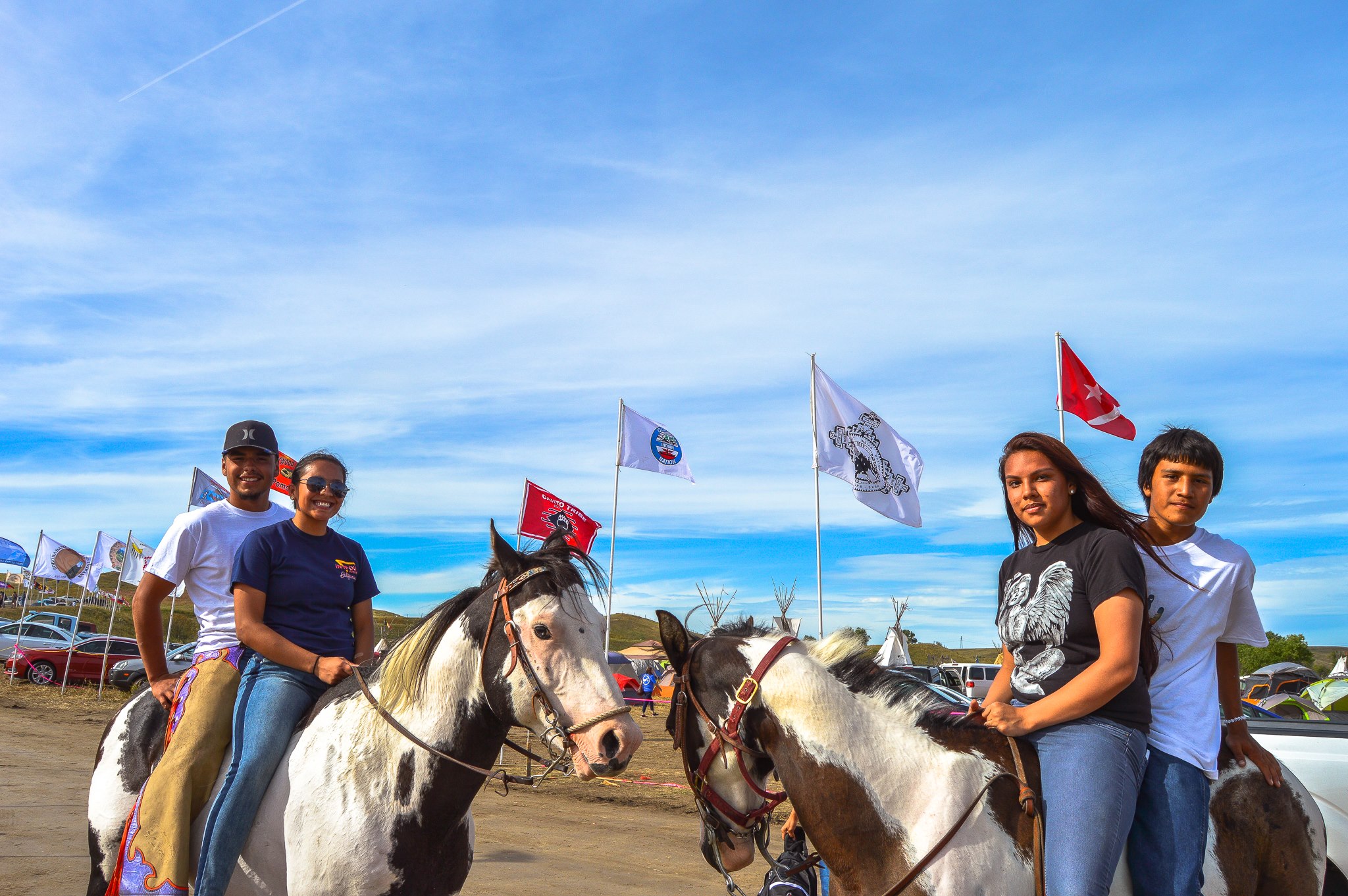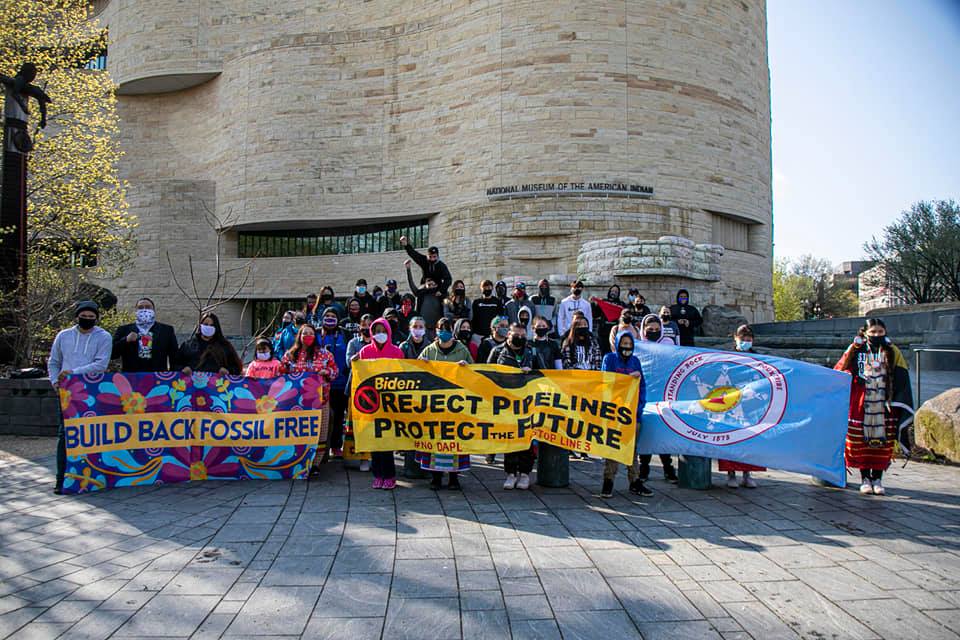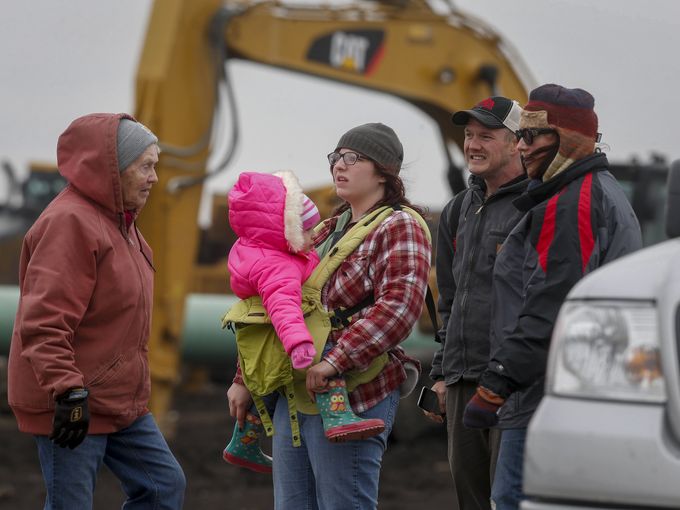
Young water protectors from Iowa made the trip to Sacred Stone Camp to stand with Standing Rock Sioux Tribe and all the people who oppose the Dakota Access Pipeline. Sept. 12, 2016. (Photo by Rob Wilson for Bold Alliance)

“Defend the Sacred: Killing the Black Snake” (Photo by Ryan Vizzions / No Spiritual Surrender, Standing Rock, 2016)
Despite a mass uprising and months-long occupation on Lakota lands on and near the Standing Rock Sioux Indian Reservation in North Dakota, a movement started to protect Indigenous sacred sites and water sources that spawned solidarity actions across the U.S. and the world, Energy Transfer Partners’ controversial Dakota Access (DAPL) Pipeline was completed in 2017. The line currently carries light sweet crude oil from the Bakken/Three Forks production area in Stanley, North Dakota across South Dakota and Iowa to Patoka, Illinois. A proposed expansion would increase capacity from 570,000 to 1.1 million barrels per day.
A court-ordered Environmental Impact Statement review is currently underway, expected to be completed by the Biden administration in March 2022, that includes under its parameters new consultation with the Standing Rock Sioux Tribe and other Tribal Nations, and a more thorough investigation into potential oil spill impacts. Meanwhile, oil continues to flow through DAPL despite a federal court having vacated a vital easement from the Army Corps to cross Lake Oahe. Water Protectors and Pipeline Fighters continue to pressure the Biden administration to #ShutDownDAPL during the court-ordered environmental review, and ultimately shut down the illegal pipeline completely and for good.
On May 21, a federal judge ruled DAPL will be allowed to operate during the environmental review scheduled for completion in March 2022, saying authority rests with the Army Corps and not the courts; the ruling follows the Biden administration and Army Corps repeatedly taking the position that it saw no reason to shut down the pipeline during the environmental review, despite lacking a valid easement. Judge Boasberg noted the Army Corps “conspicuously declined to adopt a conclusive position regarding the pipeline’s continued operation, despite repeated prodding from this Court and the Court of Appeals to do so.”

Indigenous youth-led White House ShutDownDAPL & StopLine3 action gathering at National Museum of the American Indian, April 1, 2021 (Photo: Indigenous Environmental Network)
Media Coverage
- (May 21, 2021): Bloomberg: Dakota Access Avoids New Shutdown Order From Federal Court
- (April 2, 2021): Indianz.com: ‘Shut down DAPL’: Lakota youth bring black snake to Biden’s front door
- (April 13, 2018): High Country News: Cashing in on Standing Rock
- (May 27, 2017): The Intercept: Oil & Water: Leaked documents and public records reveal a troubling fusion of private security, public law enforcement, and corporate money in the fight over the Dakota Access pipeline.
- (Feb. 22, 2017): NPR: Key Moments In The Dakota Access Pipeline Fight
- (Jan. 31, 2017): The New York Times: The Youth Group That Launched a Movement at Standing Rock
- (Aug. 24, 2016): The New York Times: Taking a Stand at Standing Rock, by David Archambault II
Project Details
- Owner: Energy Transfer Partners (38.2%), Enbridge (27.6%), Phillips 66 (25%), Marathon Petroleum (9.2%)
- Capacity: 570,000 barrels per day (current); 1.1 million (proposed expansion)
- Length: 1,172 miles
- Diameter: 30-inches
- Cost: $3.78 billion
- Status: OPERATING / PROPOSED EXPANSION
- Start Year: 2017
- Bank lenders: The pipeline project costs $3.78 billion, of which $2.5 billion is being financed by loans, while the rest of the capital was raised by the sale of a 49% stake in Dakota Access, LLC (36.8% indirect stake in the pipeline) to Enbridge and Marathon Petroleum.
- The loans have been provided by a group of 17 banks, including Citibank, Wells Fargo, BNP Paribas, SunTrust, Royal Bank of Scotland, Bank of Tokyo-Mitsubishi, Mizuho Bank, TD Securities, ABN AMRO Capital, ING Bank, DNB ASA, ICBC, Sumitomo Mitsui Banking Corporation (SMBC Nikko Securities) and Société Générale
- Insurers: MetLife is a top bondholder in the Dakota Access Pipeline (DAPL). In 2019, the pipeline raised $2.5 billion in net proceeds from a bond offering purchased by U.S. insurance companies and mutual funds. According to data from Rainforest Action Network, MetLife owns the largest share in two of the three tranches of the bond (12.91 and 11.07%) and second largest share in the third (6.33%). [source].
Project Status
Eminent Domain:
-

Iowa landowner and farmer Shirley Gerjets (left), who sued to stop eminent domain taking of her land for DAPL, invited guests to participate in nonviolent direct actions to stop pipeline construction on her property in November 2016. (Photo: Des Moines Register)
May 2019: Landowners and the Sierra Club in Iowa challenged DAPL’s authority to use eminent domain to take land for the pipeline against their wishes in court, which was granted by the Iowa Utilities Board in 2016. In May 2019, the Iowa Supreme Court affirmed the Iowa Utilities Board’s decision to grant eminent domain authority to DAPL. [Des Moines Register, Forbes]
- January 2017: Over a dozen North Dakota landowners sue Dakota Access, claiming the company and its contractors used unfair tactics, fraud and civil conspiracy to obtain easements — pushing them into into accepting compensation that was far lower than what other landowners received when they were told they’d lose money or get nothing if they didn’t sign. [source]
- August 2016: Dakota Access claims to have secured voluntary easements with 99% of landowners along the route through North Dakota, South Dakota, Iowa, and Illinois.
Indigenous Free, Prior & Informed Consent; Consultation & Environmental Justice:
- No free, prior & informed consent. Free, Prior and Informed Consent (FPIC) is a specific right that pertains to Indigenous peoples and is recognized in the United Nations Declaration on the Rights of Indigenous Peoples (UNDRIP). It allows them to give or withhold consent to a project that may affect them or their territories. Once they have given their consent, they can withdraw it at any stage. Furthermore, FPIC enables them to negotiate the conditions under which the project will be designed, implemented, monitored and evaluated. This is also embedded within the universal right to self-determination. [source]
- April 2021: The Biden administration via the U.S. Army Corps of Engineers and other agencies continues to conduct consultations with Standing Rock, other Tribal Nations for an updated DAPL environmental review expected to be completed by March 2022. [source]
- January 2021: The Biden administration issues an updated White House Memorandum on Tribal Consultation and Strengthening Nation-to-Nation Relationships, which does not refer directly to Free, Prior & Informed Consent, but does return the U.S. government to Obama-era (or better) efforts to “strengthen” Tribal consultation and sets out directives for federal agencies.
- March 2020: A federal court rules the Army Corps analysis of pipeline impacts is inadequate, orders a full environmental review that includes additional consultation with the Standing Rock Sioux Tribe and other Tribal Nations.
- November 2016: U.S. Army Corps under President Obama announces that “the Army has determined that additional discussion and analysis are warranted in light of the history of the Great Sioux Nation’s dispossessions of lands, the importance of Lake Oahe to the Tribe, our government-to-government relationship, and the statute governing easements through government property.”
Outstanding Permits:
- 2021: DAPL continues to operate, despite a federal court having vacated a key easement to cross Lake Oahe.
- June 2019: Energy Transfer files permit applications and notifies affected states about plans to “optimize” the existing Dakota Access Pipeline to increase capacity from 570,000 barrels per day to 1.1 million, by adding pumps at new and existing pump stations along the route — but not adding any new pipeline construction.
- January 2017: President Trump signs an executive order encouraging DAPL construction to proceed, instructing the Army Corps to “take all actions necessary and appropriate” to review and approve the pipeline “in an expedited manner… to the extent permitted by law and as warranted.” In February 2017, the Army Corps granted the necessary easement for Lake Oahe.
- December 2016: U.S. Army Corps under President Obama announces it will not grant a necessary easement for DAPL to cross Lake Oahe.

Standing Rock Sioux Chairman Dave Archambault II talking with reporters on 8 Sept 2016. (Photo by Rob Wilson for Bold Alliance)
Impact Litigation / Court Fights
- Federal Court:
- May 2021: Federal judge rules DAPL allowed to operate during environmental review, says authority rests with Army Corps and not courts; ruling follows Biden administration / Army Corps ‘reiterated‘ position allowing DAPL to operate during environmental review. [source]
- Judge Boasberg: Army Corps “conspicuously declined to adopt a conclusive position regarding the pipeline’s continued operation, despite repeated prodding from this Court and the Court of Appeals to do so”
- April 2021: The Biden administration declines to shut down DAPL during the ongoing environmental review, despite lacking a key easement for the pipeline to cross Lake Oahe. [source]
- March 2020: U.S. District Court for the District of Columbia rules the existing Army Corps analysis of the pipeline’s impacts is inadequate and that the agency must conduct a full Environmental Impact Statement under guidelines set out in the National Environmental Policy Act.
- May 2021: Federal judge rules DAPL allowed to operate during environmental review, says authority rests with Army Corps and not courts; ruling follows Biden administration / Army Corps ‘reiterated‘ position allowing DAPL to operate during environmental review. [source]
- State Court:
- May 2019: Iowa Supreme Court affirms the Iowa Utilities Board’s decision to grant eminent domain authority to DAPL. [source]
- 2016: Iowa landowners and Sierra Club challenge DAPL eminent domain authority in state court.
[Select information and map data excerpted from Global Energy Monitor, with permission and Creative Commons license.]


